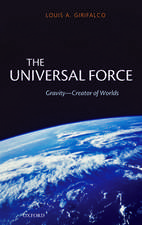Modern Mathematical Models of Time and their Applications to Physics and Cosmology: Proceedings of the International Conference held in Tucson, Arizona, 11–13 April, 1996
Editat de W. G. Tifft, W. J. Cockeen Limba Engleză Paperback – 5 noi 2012
Preț: 394.51 lei
Nou
Puncte Express: 592
Preț estimativ în valută:
75.51€ • 82.05$ • 63.47£
75.51€ • 82.05$ • 63.47£
Carte tipărită la comandă
Livrare economică 21 aprilie-05 mai
Preluare comenzi: 021 569.72.76
Specificații
ISBN-13: 9789401063722
ISBN-10: 9401063729
Pagini: 408
Ilustrații: V, 396 p.
Dimensiuni: 160 x 240 x 21 mm
Greutate: 0.57 kg
Ediția:Softcover reprint of the original 1st ed. 1997
Editura: SPRINGER NETHERLANDS
Colecția Springer
Locul publicării:Dordrecht, Netherlands
ISBN-10: 9401063729
Pagini: 408
Ilustrații: V, 396 p.
Dimensiuni: 160 x 240 x 21 mm
Greutate: 0.57 kg
Ediția:Softcover reprint of the original 1st ed. 1997
Editura: SPRINGER NETHERLANDS
Colecția Springer
Locul publicării:Dordrecht, Netherlands
Public țintă
ResearchCuprins
Day 1 Sessions 1–3.- Session 1. The Redshift.- The pair of X-ray sources across NGC 4258, its relation to intrinsic redshifts, ejection and quantization.- A fresh look at discordant redshift galaxies in compact groups.- Evidence for quantized and variable redshifts in the cosmic background rest frame.- Testing for quantized redshifts. I. The project.- The distribution of galaxy pair redshifts.- Session 2. Critical Properties of the Universe.- Density fluctuations on super-Hubble scales.- The challenge of large-scale structure.- Electric space: evolution of the plasma universe.- Gamma-ray bursts: should cosmologists care?.- Session 3. Statistical Methods.- Testing for quantized redshifts. II. The local supercluster.- Power spectrum analysis and redshift data.- Statistical analysis of the occurrence of periodicities in galaxy redshift data.- Zooming in on the redshift problem.- Day 2 Sessions 4–5.- Session 4. New Approaches to Cosmology.- Two universes.- Anomalous redshifts and the variable mass hypothesis.- Three-dimensional quantized time in cosmology.- Session 5. Gravitation and Time in General Relativity.- The stress-energy tensor and the deflection of light in 6-dimensional general relativity.- Einstein’s greatest mistake?.- Time, space and complex geometry.- Discrete spatial scales in a fractal universe.- Possible new properties of gravity.- On the cosmic limits of physical laws.- Changes in concepts of time from Aristotle to Einstein.- On the transmutation and annihilation of pencil-generated spacetime dimensions.- Day 3 Sessions 6–7.- Session 6. Nuclear and Particle Physics.- Particles, space and time.- Time anisotropy and quantum measurement: Clues for transcending the geometrical picture of time.- 3-D Period doubling and magnetic moments of particles.-Relics of the primordial origins of space and time in the low energy world.- Unexplained empirical relations among certain scatterings.- Spherical rotation, particles and cosmology.- Session 7. Mathematical Models and Methods.- A Non-linear model for time.- Defining spacetime.- Some elementary geometric aspects of extending the dimension of the space of instants.- Fisher information as a measure of time.














